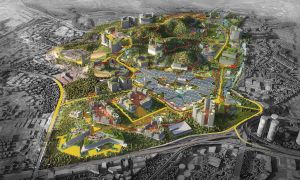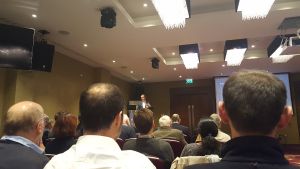Lincoln has just published a new article in The Nature of Cities entitled 'Biophilic Benefits of Bio-baloney'. The article investigates whether exposure to greenery and nature improves employee wellbeing, and, in turn, productivity and creativity. A link to the article is as follows: https://www.thenatureofcities.com/2017/11/12/biophilic-benefits-bio-baloney-probably-former/
Lincoln and Mike have just published a new paper in the on-line journal Conservation Evidence entitled 'Performance of artificial maternity bat roost structures near Bath, UK'. The paper describes the design features of two structures and the results of monitoring surveys undertaken to determine their success in re-establishing displaced Brown Long-eared bat and Common Pipistrelle bat maternity colonies. This article can be downloaded from our publications page.
Biodiversity by Design informed the adjudication of the competition to design a pretigious new hyper-green development and transport hub east of Paris. Marne-Europe, situated at the western limits of the new ecoregion of Marne-la-Vallée, will include a new mainline station linking through to the UK and constitute a transport hub around which a new urban village will emerge. The development is to be conceived based on the latest thinking in green design and ecourbanism. Previously, Biodiversity by Design had furnished the candidate teams (on behalf of the governing body of Marne-la-Vallée, EPAMarne) with a state of the art ecological design vision document to demonstrate approaches that could maximise the provision of ecosystem services and the value of the scheme to biodiversity.
See the winners of the competition by visiting the following page:
https://www.epamarne-epafrance.fr/espace-presse/marne-europe-le-groupement-balcon-sur-paris-laureat-de-inventons-la-metropole-du-grand-paris/
Dr Mike Wells' article on the biophilic design of the Wandsworth Riverside Quarter, London has been published in the Biophilic Cites Journal.
Lincoln Garland's article 'The Case for High Density Compact Cities' was awarded Highly Commended in the In-Practice category at CIEEM's 2017 Best Practice Awards
The prestigious Suasana 2C5 office and retail complex has just been completed in Putrajaya, Malaysia's federal administrative centre (aka the 'City in the Garden'). BbD provided ecological input to the landscape design. Biodiverse landscape permeates the entire development including interior spaces, plazas, atriums and building façades, the latter of being perforated with cantilevering lush green vegetated balconies. A video describing the landscape is available at - https://drive.google.com/file/d/0B_z_ZIWecK_XdXlxbHNBSVBzSk0/view?usp=sharing
Lincoln and Mike have just published a new article in the on-line Preprints Journal - Defining the West of England's Genius Loci: 'Land of Limestone and Levels' to Lateral Thinking
Lincoln and Mike have just published a new article in the on-line Preprints Journal - Rainforest to Reef: A Landscape-scale Approach to Coastal Ecotourism in Malaysia. The Rainforest to Reef strategy recently won GOLD AWARD at the Singapore Institute of Landscape Architects Awards. This article can be downloaded from our publications page.
Dr Mike Wells was asked by renowned author Professor Timothy Beatly to review his new book 'Handbook of Biophilic City Planning & Design'.
'To those new to the concept of biophilic urbanism, this excellent handbook will be eye-opening. To practitioners and green urbanism theorists, there is much by way of useful, global information.'
The book is a publication that maintains the flow of information on green and ecological design of cities for man and nature at a time when information exchange and awareness between practioners is more important than ever.
Read Mike's full review here: https://www.thenatureofcities.com/2017/05/29/biophilias-place-integrated-approach-urban-planning/
Biodiversity by Design is part of a winning team for the Masterplan of the University of Malaya. In 2016 Ken Yeang, founding director of TRHY and one of the world's leading green architects, was the recipient of the Liang Sicheng Architecture Award. This the highest accolade awarded by the Architectural Society of China.
The University of Malaya intends to re-design its campus, moving it into the new technological era of the twenty-first century, and achieving its core vision and mission of becoming 'an internationally renowned institution of higher learning in research, innovation, publication'. The Institution's goal is to become a world class research university, making a significant contribution to Malaysia's new economic model and the coveted status of becoming a developed nation.
The University required that the new masterplan preserves its key biodiversity and landscape assets, in particular Rimba Ilmu Botanical Gardens.
Amongst the core objectives in the brief from the University was that the University of Malaya should become a technologically advanced and sustainable 'Eco-Campus' by:
o Conserving Rimba Ilmu's biodiversity, but also enhancing public access and visual presentation.
o Proposing rehabilitation strategies for existing water-ways.
o Developing a landscape master plan.
o Creating a walkable campus.
o Increasing campus carbon sequestration capacity.
o Integrating green technology into infrastructure, campus planning, and public amenities.
o Developing a campus-wide waste management strategy.
o Create opportunities for outdoor learning and recreation to enhance wellbeing of the campus community.
Biodiversity by Design's contributions to the bid included putting a strong emphasis on innovative ways of encouraging positive interactions with and learning about native biodiversity and strengthening of links to the wider green network.

The Rainforest to Reef strategy conceived by Biodiversity by Design and Grant Associates - a landscape-scale approach to coastal ecotourism covering Endau Rompin National Park (Malaysia) and its hinterland - scooped GOLD AWARD at the Singapore Institute of Landscape Architects Awards.
Dr Lincoln Garland's recent article 'The Case for High-Density Compact Cities' has been shortlisted as a finalist in the 2017 CIEEM In Practice Award category.
Director Mike Wells gives a presentation on mainstreaming biodiversity into cites at the 2017 CIEEM Spring Conference. His talk included ways of mainstreaming biodiversity into cities, such as by using exisiting policy and strategy to create a powerful economic and social case as to why biodiversity should be included into urban design. As well as exploring the benefits of incorporating biodiverse ecology and biophilic design into cities, rather than just 'greening' the cities which have no real functional benefit for fauna and thus the biodiversity of cities.

Director Dr Mike Wells made his latest contribution to The Nature of Cities website with a focussed piece on the question: What are ambitious goals and targets for biophilic cities? What are the right metrics for progress toward such goals?
Find this contribution HERE>
Dr Mike Wells attended the Property Innovation Series held by Houzen & Assael Architects and facilitated a discussion forum on envisaging the land around the Marble Arch in 2025.
Dr Mike Wells gives a CPD talk to 35 staff at Allies & Morrison in London on the importance of putting biodiversity and landscape at the heart of urban master planning.
Jenny Lovell, Architech, described the talk as 'interesting and very thought provoking'.
Dr Mike Wells, a visting research fellow of the Bath School of Architecture and Civil Engineering, completed a series of four lectures to the 5th year students of Bath University's Architecture programme.
The lectures were a series on the use of Environmental Impact Assessments, the importance of green design being integrated into architecture from the outset rather than being 'added-on' at a later stage, as well as ideas and thoughts on how to include green roofs, facades and ecological key notes into the design of buildings in order to make them unique and ecologically sensitive designs.
It has long been recognised that cities exhibit their own microclimate and are typically warmer than the surrounding rural areas. This 'mesoscale' influence is known as the urban heat island (UHI) effect and results largely from modification of surface properties leading to greater absorption of solar radiation, reduced convective cooling and lower water evaporation rates.
Dr. Mike Wells, K.R. Gunawardena and T. Kershaw and have recently been published in an article on this subject in the peer reviewed journal: Science of the Total Environment
http://www.sciencedirect.com/science/article/pii/S0048969717301754
Or please request a copy from info@biodiversitybydesign.co.uk
BbD is delighted to announce that Bethan Cainey has successfully completed her Masters Degree in Environmental Consultancy from the University of the West of England. She achieved a distinction for her dissertation "Do drought conditions affect phenological timings of grassland species in semi-improved grasslands in the South West of England?"
Director, Dr Mike Wells said "What impressed me about Bethan's commitment was that she was the only student on her course to do a field resesarch Masters, gathering her data in all weathers from her field site. The topic is an important one in light of the inevitable consequences of climate change for our native flora and fauna. Well done, Beth. Now get back to work."
Dr. Mike Wells has been published in the peer reviewed journal: Science of the Total Environment.
This article reviews the mitigation of the urban heat island effect by green and blue infrastructure. There are some counter-intuitive results especially as regards the effects of large urban water bodies.
The document can be found at: http://www.sciencedirect.com/science/article/pii/S0048969717301754
Director Dr Mike Wells has contributed again to a focussed debate on David Maddox's wonderful website The Nature of Cities, addressing the following question:
In terms of creating better cities, ecologists and landscape architects have a lot in common, but sometimes talk past each other. From your perspective, what is one critical idea from your profession that is not reaching "across the aisle"? How can we get this idea better integrated?
Mike's full contribution can be downloaded here along with one by Andrew Grant, the world-renowned landscape architect, who refers very favourably to Mike in his article.